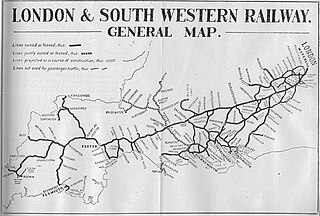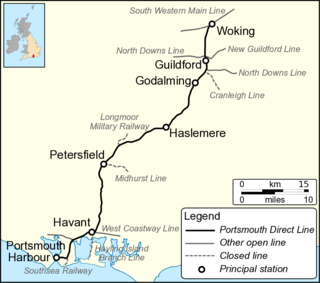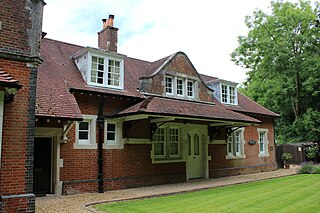
The London and South Western Railway was a railway company in England from 1838 to 1922. Originating as the London and Southampton Railway, its network extended to Dorchester and Weymouth, to Salisbury, Exeter and Plymouth, and to Padstow, Ilfracombe and Bude. It developed a network of routes in Hampshire, Surrey and Berkshire, including Portsmouth and Reading.

Gosport is a town and non-metropolitan borough, on the south coast of Hampshire, South East England. At the 2021 Census, its population was 81,952. Gosport is situated on a peninsula on the western side of Portsmouth Harbour, opposite the city of Portsmouth, to which it is linked by the Gosport Ferry. Gosport lies south-east of Fareham, to which it is linked by a Bus Rapid Transit route and the A32. Until the last quarter of the 20th century, Gosport was a major naval town associated with the defence and supply infrastructure of His Majesty's Naval Base (HMNB) Portsmouth. As such over the years extensive fortifications were created.

The Southern Railway (SR), sometimes shortened to 'Southern', was a British railway company established in the 1923 Grouping. It linked London with the Channel ports, South West England, South coast resorts and Kent. The railway was formed by the amalgamation of several smaller railway companies, the largest of which were the London and South Western Railway (LSWR), the London, Brighton and South Coast Railway (LB&SCR) and the South Eastern and Chatham Railway (SE&CR). The construction of what was to become the Southern Railway began in 1838 with the opening of the London and Southampton Railway, which was renamed the London & South Western Railway.

Portsmouth Harbour is a 1,264.2-hectare (3,124-acre)/12.6 km2 (4.9 sq mi) biological Site of Special Scientific Interest between Portsmouth and Gosport in Hampshire. It is a Ramsar site and a Special Protection Area.

The West Coastway line is a railway line in England linking the conurbations of Brighton/Hove/Littlehampton and Southampton/Portsmouth, with 1.3 million people between them. It has short southward branches to Littlehampton and Bognor Regis, which offer direct services to and from London.

The Portsmouth Direct line is a railway route between Woking in Surrey and Portsmouth Harbour in Hampshire, England. It forms the principal route for passenger trains between London, Guildford and Portsmouth; connections are made to the ferry services which operate between Portsmouth and the Isle of Wight. The final section of line from Havant to Portsmouth is shared with other passenger routes.

The Southsea Railway was a short railway branch line. It was built to give easier access from the jointly operated main line railway approaching Portsmouth to the Clarence Pier from which Isle of Wight ferries sailed. In 1879 the extension of the main line railway to Portsmouth Harbour station, where direct transfer from train to steamer was possible, eliminated most of the steamer business at Clarence Pier. Undeterred, promoters interested in developing Southsea projected the Southsea Railway, connecting a new Fratton station on the main line, with Southsea. The line was opened on 1 July 1885. Its independent promoters believed that it could be a main line terminus for London trains, and they constructed the line lavishly in consequence.

Salisbury railway station serves the cathedral city of Salisbury in Wiltshire, England. It is 83 miles 43 chains (134.4 km) from London Waterloo on the West of England line to Exeter St Davids. This is crossed by the Wessex Main Line from Bristol Temple Meads to Southampton Central. The station is operated and served by South Western Railway (SWR), and is also served by Great Western Railway (GWR).

Fareham railway station is on the West Coastway Line situated about 0.62 miles (1 km) from the town of Fareham in Hampshire, England. It is 84 miles 21 chains (135.6 km) down the line from London Waterloo.
The Bishop's Waltham branch was a railway line in Hampshire, England. It was made by a locally promoted independent company, the Bishop's Waltham Railway company. It ran from Bishop's Waltham to Botley on the Eastleigh–Fareham line of the London and South Western Railway (LSWR). The line opened on 1 June 1863.

Eastleigh railway station serves the town of Eastleigh in the county of Hampshire in England. It is located on the South West Main Line and is the junction station for two other routes, the Eastleigh-Fareham Line and the Eastleigh-Romsey Line. It is 73 miles 35 chains (118.2 km) from London Waterloo. South of the station are Eastleigh Railway Works and Eastleigh Depot.
The Meon Valley Railway was a cross-country railway in Hampshire, England, that ran for 22 miles (36 km) between Alton and Fareham, closely following the course of the River Meon. At its northern (Alton) end, it joined with the Alton Line from London. It was conceived as an additional main line to the area around Gosport, and it was opened in 1903. It never fulfilled its planned potential, and remained a local line through sparsely populated agricultural areas, and it closed to passenger services in 1955; some local goods services continued until total closure in 1968.
The Southampton–Fareham line is a railway line in England, along the south coast of Hampshire. As a through line it came late in British Railway history, traversing unpromising coastal terrain. The first part from Portswood, near Southampton, to Netley was opened in 1866, prompted by the establishment of the Royal Victoria Hospital at Netley, which had been established for the care of wounded soldiers.

Droxford railway station was an intermediate station on the Meon Valley Railway, built to a design by T. P. Figgis and opened in 1903. It served the villages of Droxford, Soberton and Hambledon in Hampshire, England. The railway served a relatively lightly populated area, but was built to main line specifications in anticipation of it becoming a major route to Gosport. Consequently, although the station was built in an area with only five houses, it was designed with the capacity to handle 10-carriage trains. It initially proved successful both for the transport of goods and passengers, but services were reduced during the First World War and the subsequent recession, and the route suffered owing to competition from road transport.
The Gosport and Cosham lines were a collection of railway lines in southern Hampshire. Most of the lines are now closed but some elements are still in use, forming part of the West Coastway line. The lines originally linked to the main London to Southampton line via the Eastleigh–Fareham line and subsequently with a line from Southampton via Bursledon, both of which are still in use.
The Stokes Bay line was a short railway branch line in Hampshire, England, near Gosport. Associated with a new pier, it was intended to give direct and easy access from trains to steamers to the Isle of Wight in comparison to the conventional route through Portsmouth, which required a road transport connection though the town. Railway operation to the Stokes Bay pier started in 1863.
The Lee-on-the-Solent Line was a three mile long railway in Hampshire, England; it was built by the Lee-on-the-Solent Railway Company, promoted in association with a landowner's wish to develop a new seaside resort on his land.

The Portsmouth line is a secondary main line originally built by the London, Brighton and South Coast Railway and the London and South Western Railway between 1847 and 1868. It leaves the South London Line at Peckham Rye, with connections to the Victoria branch of the Brighton Main Line at Streatham, and continues via Sutton, Epsom and Dorking to join the Mid-Sussex Line at Horsham.

The Portsmouth and Ryde Joint Railway was a group of three railway lines in Southern England that were jointly owned and operated by the London and South Western Railway and the London, Brighton and South Coast Railway. The main line was between Cosham and Portsmouth Harbour; there was a branch from Fratton to East Southsea; and a line between Ryde Pier Head and Ryde St John's Road. The last-named section was isolated from the others, being on the Isle of Wight. The first section of line opened in 1847 and the last in 1885; the Southsea branch closed in 1914 but all of the other routes have since been electrified and remain open.
The Portsmouth to Brighton Railway was built by the London, Brighton and South Coast Railway and its immediate predecessor in several stages.














